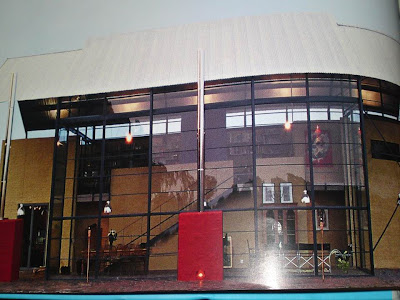main loads causes by = GRAVITY ( live and dead loads), vertically downwards
= WIND (positve and negative loads) , mainly horizontal and multi directionl
REINFORCED CONCRETE
THE BEAM
concrete = compressive strength
steel = tensile strength
- together = combination =best result
reinforcing - adequate cover + 40mm
= bar has good grip to a body of concrete
= no danger of moisture causing corrosion and spalling
- cantilever = a projecting beam supported at one end
- force of the bending moment = a combination of the load and it's distance from the point of support.
- beams spanning across columns = rienforcing is added at right angles to these lines to resist against failure ( shear failure)
simple slab - smaller spans between supports
= no beams needed
mushroom - very economical
= for large areas of spaces with no complications
flat rib - development of mushroom slab
= allows longer spans in one direction
pick rib - beams pick up slab loads and covey them to columns
= slab becomes thinner
ribs - slab between ribs can be very thin
= resemble hollow slab
coffer/waffle slab - combination of slab and beam
= reasonable overall depth for spans
THE COLUMN
columns = transmit loads from the building to the foundations at given points.
slenderness ration of a column = ration of width or thickness to height = reinforcing needs to be added for a column to take on much more load.
column - one side is in tension and another in compression
= reinforcing is evenly and symmetrically placed = avoid buckling
- concrete columns and beams are much thicker than steel = juctions (structural elements0 for more rigid and secure.
- at junctions = reinforcing bars take bending moment loads
- at multi-storey buildings = at higher levels columns remain the same size as the lower level = standard size (formwork and finishes)
POPULARITY OF CONCRETE
concrete = fludity - may be moulded to variety of shapes
= pipes and services may be cast in
= finish - keeps its good appearance for longer
=inherent quality lasts indefinitely
= becomes harder and stronger with age
= natural material(sand and stone)
resistance to corrosion
ADVANTAGES OF FRAMED STRUCTURES
- steel and concrete frame replacing masonry or brick load bearing structure
- frame can span freater distances
-larger openings(internally and in hte envelope)
-no load bearing walls = maybe placed anywhere = flexibility in planning
- walls may be of any material (provide basic functions0
- lighter partitions = structural savings
STEEL STRUCTURES
governing principles of steel structure = concrete
- yet method of using some cases differs and overall appearance is very different
-steel = is a different type of material
= very strong structurally
= useful tensile qualities(better tensile, higher cost)
= because of stength -reads lighter and elegant
= by nature -flexible
= lower depth-to-span ratio than concrete
STRUCTURAL SHAPES/SECTIONS
- flat steel bar = easily bend
- steel ange will resist a moderate load yet vertical flange under compression will buckle
- resist = add another flange = channel
-more strength = I beam / H section beam - hot rolled sections, process of manufacture
columns = I/H section
trusses = combination of sections used
shorter beam spans = I section
LIGHT GUAGE SECTIONS
- refers to as cold rolled pressed or light guage
- forms = door jambs, in painted steel etc.
- for light loads and smaller spans
- former range from about 8-20mm thick, later average 2mm
- common = roof purlins, vertical sheet clading rails for industrial buildings
COMMON STRUCTURAL FORMS
- barcing or triangulation
- in steel because of smaller joints and flexibility of steel , trusses have to be braced
- rectangular arrangement of members with weak joint will stabilise with bracing
- two ties of bracing are lighter and less costly than one stiff brace = movement maybe in amy direction, therefore, prevented
- application = work out the tendency of movement first then arrange braced to act in tension
- purlins are placed at the jionts where the load is distributed to 3 memebers ar once
-lattice principle(interlaced structure or pattern) make up a prtial frame(entrance0
application = H sections
- stanchions = columns
- roof trusses need to take upward lift = wind, wight of structure is not as strong as the downward force.
- steel framed buildings have additional bracing to prevent movement or deflection in the overall structure.
-steel sheeting for roofing and cladding is profiled(corrugated)
= placed at the top and bottom of teh given depth to stabilise it along its length
= deeper the profile - greater the span
= thicker the sheet - greater the span
- most economical = arranges/ designs must be suitably combined
- principle then = construct the envelope of a thin spanning material, rests on a secondary maybe tertairy support system, rests on main structural frame, rests on columns, rests on foundations, rest on the earth.
- in concrete the lattice principle maybe used in two directions = space frame
depth-to-span ratio
solid I beam = 1:50
castellated beam = 1:40
lattice/space frame = 1:16-20
concrete = 1:12-15
ADVANTAGES OF STEEL
-quick site erection
- structural elements occupy less space
- large span-to-depth ratio
- lighter overall weight than concrete
- elegant and aesthetically apealing
recycleable
DISADVANTAGES OF STEEL
- corrosion from moisture is a problem
- maintenance cost problem
- fire will weaken stel cause to collapse
- movement is more
- quite noisy
REFERENCE
PRINCIPLES OF STRUCTURE IN BUILDING
BY MIKE RODSETH
kIsSeS.... :-)




















